Page 1 - The Biggies
Page 2 - The Mediums
Page 3 - The Others
Page 4 - Accessories & Awards
Previous Glee reviews:
Glee 2008 - Review - Page 2 of 4
StoneFlair:
Apparently, I gave StoneFlair some stick last year regarding the poor build quality, so the powers-that-be at AI decided to let the obscenely over-talented Leighton Powell and his team from Ability Garden Company build both the Bradstone and the StoneFlair stand this year, and what a cracking wheeze that turned out to be. This was, by some considerable distance, the best display StoneFlair have ever put together, and while a simplified design and reduced number of products obviously contributed to that success, a good portion of the credit has to go to Leighton's knack of focusing on quality workmanship which shows off the products to best effect.
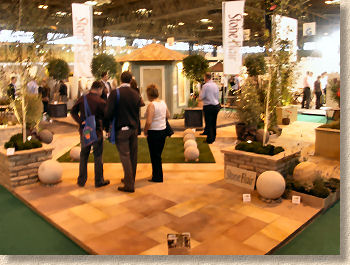
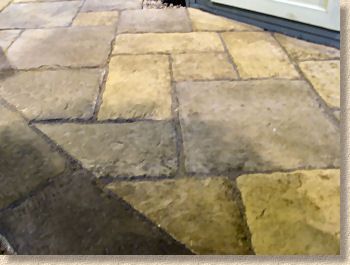
A simpler range of new products was, for me, topped by the impressively re-worked Bamburgh Mill range, which can now rightly claim a place at the top table of wet-cast reproduction flagstones. The moulds are exquisitely detailed, the casting is near perfect and the introduction of three tints within the one "Olde Blend" colour gives added authenticity and brings it very close to the Westminster Stone Old Lancashire flagstone, which, for me, still rules the roost. There's also a single shade "Mellow York" which is probably almost as good, but impossible to judge fairly under the awful sodium lights used in the hall.
Honeymede is a 6-size calibrated yellowish limestone flag that will be supplied in both large (10.2m²) and small (5.5m²) project packs. This is the basic Kotah Yellow that is increasingly popular as an alternative to the standard range of sandstones that will also be made available in the large and small project packs.
One sandstone that has been given an upgrade is the Modena which has been sawn and honed to give it that stylishly clean modern look. As with the Bradstone Refinement mentioned earlier, this will be made available as an 11.4m² project pack containing three sizes: 1000/750/500 x 500mm, as well as the so-called "Long Aspect" version.
Dark, sombre colours have become inexplicably popular over the last two or three years, but the standard black limestone has been troubled with problems of bleaching in strong sunlight (not that we've seen much of that this year!). A genuinely viable alternative is the indigo slate coming in from China. It's a blue-black shade that is light-stable and has a very lightly riven surface texture. There's also a "Rustic Gold" option featuring pyrites-like metallic highlights on a very dark background that is a little too alien for my taste, but can look good in small courtyard settings, given the right planting and patio furniture.
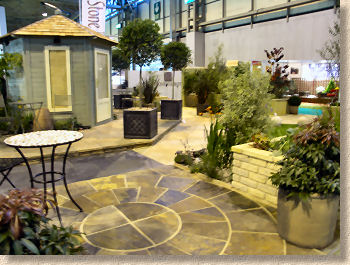
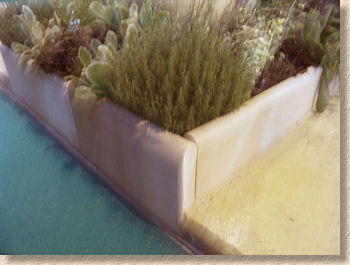
The last of the noteworthy stone products that will be new for 2009 is a delightful round-top edging is the "Rosemount" colour. It's a delicate wee thing, just 450mm in length and 25mm wide, but it is an attractive alternative to the usual riven or flag-on-edge edgings used with natural stone, and will be an essential for the smoother flagstone finishes that are becoming more popular. It needs a corner unit to complete it, but it's a certain winner and I fully expect to see it in more colour options in the very near future.
Tuscany is the concrete version of Travertine, and I can never be truly objective about Travertine because its true role in life is as bathroom tiling, not patio paving. To be fair, the so-called 'reconstituted' version is not as hideous as the genuine thing, but I still wouldn't have it on one of my projects. Now, if they were to reveal that crushed natural travertine had been used to make the aggregate for this product, I'd be a lot happier.
On a much simplified stand, there were definitely more winners than losers amongst the new products, but my abiding memory will be the simple appeal and stylish beauty of this display. It shocks and yet perversely pleases me to admit that, for once, the StoneFlair stand outdid that of their big brother, Bradstone.
Global Stone:
While other exhibitors produce a completely new display each year, Global Stone hit upon a winning layout last year and decided to stick with it. There's nowt wrong with that: if it's not broke, don't fix it, and the layout used to display their ever impressive selection of stone is very definitely not broke!
Global Stone don't have the resources of the really big companies in this market, so like all the best medium-sized traders in whatever field of business, they survive and thrive on innovation and service. In all the years I've known the company, they've never once failed to come up with something different, something impressive, something with real character. Not everything can be a winner, but many of the ideas first seen at Global Stone have been, and will be, mimicked by others.
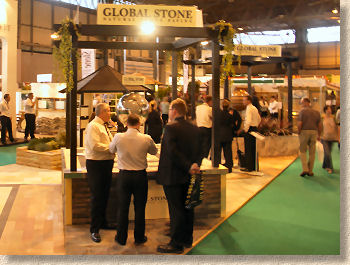
So: the stand largely replicates 2007's layout, albeit with different products. The big water feature with a horizontally sawn stone globe attracted considerable attention and sales manager, Julian Woods, reckons demand was outstripping supply, much to his pleasure. It was also pleasing to see native British stone on the stand, too, in the form of Johnson's-Wellfield distinctive yorkstone and the dark lustre of genuine Welsh Slate. In an age when the domestic paving market is dominated by Asian imports, it's easy to forget that we do have some of the best paving stone in the world right here on our own doorstep.
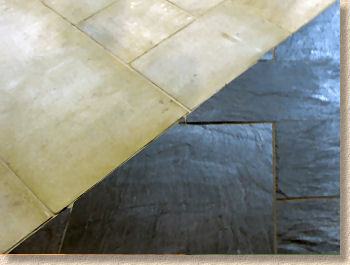
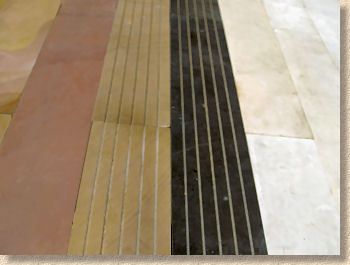
One group of products that really caught my attention were the 'linear' formats of various sawn/honed stones, and in particular the Fusion range, which has been grooved, a process that brings to mind the processed timbers used for modern decking, but also creates an illusion of even greater length to this particular format. Very attractive and an ideal contrast or break-band paving to use with other materials. This is an idea that I'm sure we'll see more of in the next few years.
However, the real star of the stand was a neatly crafted black and white 2.5m square feature that used the Monsoon black honed sandstone in the grooved long aspect format with a very light grey shot-blasted flagstone. The Global Stone team has named this the Courtyard Square and very cleverly raised it up to waist height on a dais, allowing closer inspection of the inviting tactile finish. At only 2500 x 2500mm, this will require at least one additional course of 300m or more to the outside edge to make it a serviceable patio in its own right, but with so much compatible stone on offer, the real problem will be in choosing which to use.
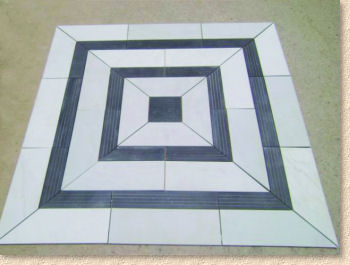
A brief mention for the Rose Cottage Clay Pavers which have a real cottage-garden look to them and a luscious orange-red colouring that will contrast perfectly with traditional planting schemes. 200x100 in plan and just 50mm deep, these can be used to create the archetypal garden path, with more character and appeal than almost any other form of paving.
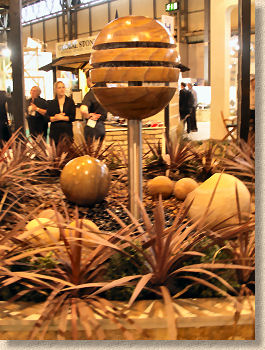
Finally, news of a very chunky new walling unit. Easy-Fix Walling is a double-faced block of rose-hued Modak stone measuring a hefty 400x200mm in plan with a bed depth of 90-100mm. It can be laid dry up to around six courses in height, or mortar bedded for extra height. Most modern natural stone walling is single faced, requiring twice as much work to construct a double-faced or free-standing wall, so this could have appeal. Its main weakness is price. As with all imported stone walling, you don't get a lot of wall to the tonne, and so on a square metre rate, it will be five or six times the cost of paving, but then you have to accept that it is five or six time the thickness of paving, and that's the reason for the chunky price. On the plus side, being a generous 200mm wide, you won't need to use a coping, as you would with a double-skinned wall, so there is potential to save a few bob.
I know I mentioned this last year, but I make no apologies for mentioning it again: the layout plan provided by Global Stone is the best aide-memoire produced by any of the exhibitors at the show. A simple A3 folded sheet identifies every product on the stand with key notes such as colours and sizes tucked in around the edges. If only other exhibitors would do something similar, it would make this annual write-up so much easier for me, but more importantly, it would be a superb prompt for those potential clients trying to recall the name of the product that was on the corner of the stand next to the water feature. As ever, the best ideas are the simple ones.
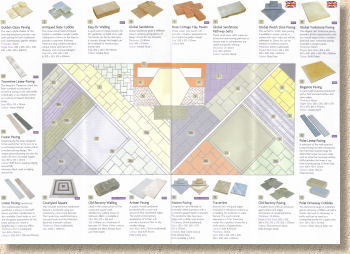
With this year's display and the new products, Global Stone continue to punch well above their weight, which is a testament to the hard work and commitment of Shirley, Julian, Paul, Glenn and all the rest of the team. This is a fiercely competitive market, and there are far too many back-street traders out there flogging sub-standard stone. When you see what Global Stone have to offer, and experience for yourself the unbridled passion they have for their products, it rubs off and reinvigorates your own passion.
Pavestone:
I'm sure Pavestone exist in an alternate universe. Their stand always seems far bigger than it can possibly be, but Kevin Fowler and his team have found a portal to another set of dimensions that allows them to cram more product into their allotted space than is physically possible, and all without any sense of feeling cramped (are you listening, Bradstone stand designers?). In fact, so massive was the task of reviewing all that Pavestone had to show that I was forced to take a break halfway through the tour to recharge my metaphysical (and camera) batteries.
If only there was some clever way of mapping all the various products on show on this enormous stand, I wouldn't have to rely quite so much on my addled memory and illegible notes, and it would also be a superb way of labelling the products for enquiring customers without having to stick unsightly labels on each and every item. Surely someone can think of a simple solution to this conundrum! Perhaps a sketch of the stand with arrows or a key to identify what was what? 
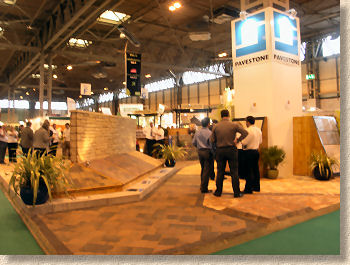
Anyway, until some mastermind comes up with a solution, I'm left relying on notes and memory, and the over-riding memory I took from this years show is the sheer range of products. Unlike other exhibitors that have reined-in their range and elected to show more of less, the Pavestone time-space continuum has been fiendishly manipulated to allow them to show more of more. Admittedly, some of the display panels were small, and gave only a taster of what was possible, but clever use of vertical displays around the periphery and on A-racks in the centre of the stand allowed generous displays of block and sett paving in relatively little floorspace, thereby allowing more bounteous presentations of those products that need additional space to reveal their real charms.
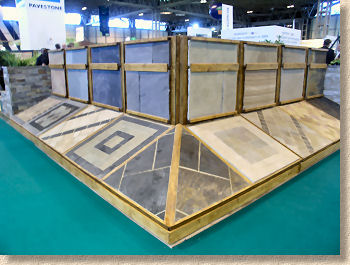
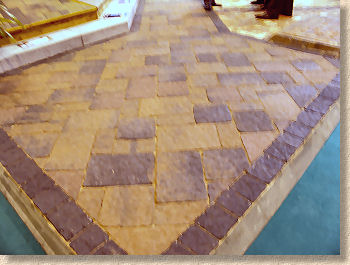
Nothing exemplified this better than the Mega-Summat* block paving. I love this large format styling; bigger than your typical blocks but smaller than a typical flagstone, it works wonderfully well on larger drives and patios where there is always a danger of creating a 'bitty' look when paving with smaller units. There was some confusion regarding actual names for the various colours, and the alleged Brindle colour was, to my eyes at least, very definitely a brown-multi, and a very nice brown multi at that.
* If I had some sort of 'map', I'd be able to check the name, because it's probably not really marketed as "Mega-Summat"
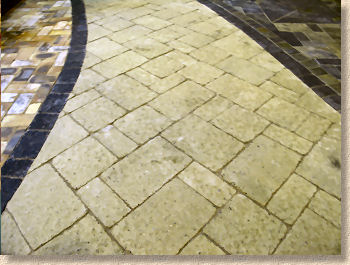
The Portland White colour (which I originally misread as Pilchard White) is a creamy ivory shade, but I'd be reluctant to use it for a driveway as that light colouring would show even the very slightest type mark. On a patio, however, particularly those along the sunny south coast of England, this will be a spectacular option.
Unlike Pavestone, I can't bend the universal dimensions to my whim, so I really don't have the space and time to cover each and every new product, so I'll have to limit myself to those I consider to be 'stand-out items'. The concrete block paving has had generous coverage above, but I will crowbar in a mention for the Marlux paving which seems to have a new distributor every 12 months or so. Shown by Global Stone last year, and Forticrete before that, it's now part of the Pavestone stable, and I do hope they can do something with it. The Europeans have taken this type of prestige residential paving to a new level and I can't help feeling that is only the lack of familiarity amongst designers and consumers that has held back its wider acceptance in Britain and Ireland.
Prior to Mr Pavestone's Damascene conversion to concrete (which, in a remarkable act of serendipity, coincided with his acquisition of a concrete production plant), Pavestone's strength as a brand was based on their eclectic range of stone paving. The 'stand-out item' of this year's stone showing would be the quartzite setts, laid as a diagonal path from the nominal 'front' of the stand to the centre. For those unfamiliar with quartzite, it's an incredibly hard form of sandstone that has been baked by metamorphism within the earth's crust to create a exceptionally hard-wearing stone with muted natural colours of brown, buffs and greys. As a stone, it's far more resistant to algae and lichens than the usual sandstones and limestones. Its only limitation is that it is very difficult to find in flagstone-size pieces, hence its appearance here as setts, which actually suit it wonderfully well.
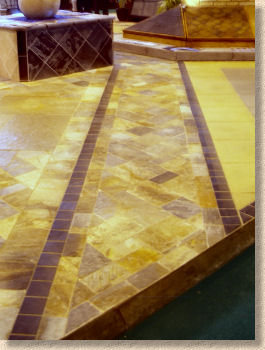
Also deserving a note is the inevitable yellow limestone flags, which on their own are nothing exceptional but had been laid adjacent to the quartzite setts where they formed a combination that worked surprisingly well.
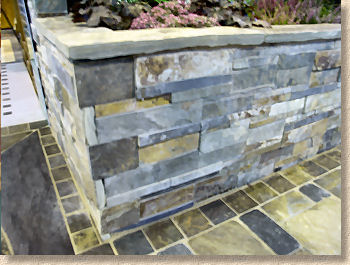
To complete the coverage for Pavestone's stone products, the modular walling should not be overlooked. Unlike many other modular walling systems, this one is more convincing, it being much more of a challenge to identify the individual modules amongst the pieces of natural stone, but the effect was diminished somewhat by having sawn edges plainly on view on the corner sections. It may be that specifically crafted corners modules are or will be available, but, at the time of writing, no information is available.
The other big product group on show was clay pavers. Pavestone have been importing all sorts of clay pavers from Belgium for several years now, but most of them have had a very European colouring and style. Now, they have a couple of pavers that look very English, both in colour and styling. The creamy-buff offering will be sold as "London Stock" and it is a very close match to the yellowy-brown hues associated with that fabled brick, and so can expect to a be a popular choice in those parts of the country where it dominates, ie: the south-east. For those of us in the more culturally advanced parts of the nation, where red bricks are more common, there is a mouth-watering soft red option that is officially unnamed, but which really ought to be crowned with the name of Cheshire, because its colour, texture and soft lime bloom are a dead ringer for the mellow bricks produced south of Manchester (the fact that Cheshire is the second most affluent area of the country won't do it any harm, either!). There is a third option: a chocolate-red colour that is archetypically Belgian/Dutch, but does provide a strong contrast to the other two, particularly the London Stock. This colour, or close to it, was featured in the clay pavers to be found in three of the gold medal winning gardens at Chelsea Flower Show earlier this year, so there will be interest, but for me, the range is crying out for a Staffordshire Blue Etruria marl brick, just to give that Cheshire Red the ideal companion.
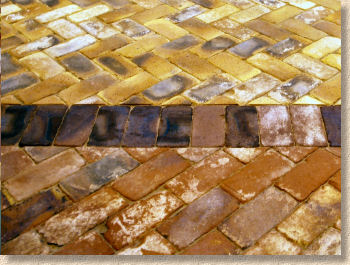
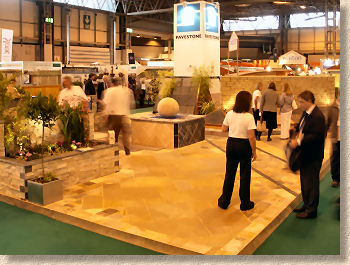
I could go on. There really was so much to see on this galactic-scale stand, that the 1,000 word per stand limit I've had to impose would barely do justice to them all, but hopefully the above will give a reasonable taster for what is available. The only thing missing from the stand as a whole is a sense of theme or coherence. While the Bradstone, Stonemarket and StoneFlair stands each had a style and a feel, Pavestone seemed more akin to a disjointed display area whose mood and aura were lacking definition. If the designers can crack that, they have the products that would enable them to steal this show.
Natural Paving:
Even now, with a number of glee-free days between me and the event, I'm not sure what happened to Natural Paving . Paul Shephard and his team have shaken up the market over the last three years, and speaking to him back in what was sold to us as a summer he was buzzing about his biggest-ever stand, so I could hardly wait to see what they had done. Shocked would be too strong a word to describe my initial reaction, but deflated wouldn't be far off the mark. It just wasn't what I expected.
Where Pavestone was probably over-faced with product, Natural Paving was coming up hungry. Don't get me wrong: what they did have was very good, but it was not truly representative of all they offer from their full range, and the reduced size of the stand along with indifferent build quality just didn't do them any favours.
I fully appreciate the economics involved, and that the budget had been reluctantly but firmly set at a level lower than had previously been hoped, but of all the major exhibitors, Natural Paving was the only one to go backwards in terms of what they had to show.
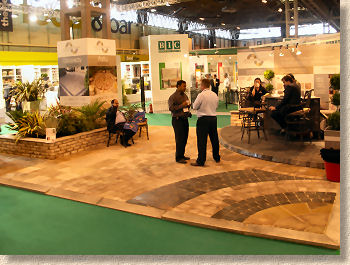
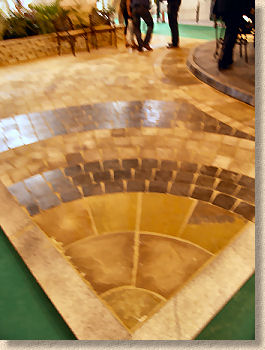
The focus was very much on their key product, the one that really impacted on the market when launched just over a couple of years back: natural stone block paving. This is, without doubt, the bread-and-butter product on the Natural Paving menu, and so it makes sense to feature it most heavily, but the layout here just didn't do justice to the blocks, whether in the sandstone, granite, slate or any other flavour. I've spent far too much time trying to figure out what was wrong with the layout and I keep coming back to the uncomfortable and poorly executed radial pattern. This produced too many wide joints that should have been taper cut to emphasise the stone rather than be filled with the otherwise excellent VDW jointing from NCC Streetscape. This was then compounded by a lack of contrast between adjacent materials.
Consider the wonderful half-battered natural stone kerb unit. Here, it had been used to create a slightly raised plinth which carried an informal bar serving nibbles and drinky-poos, but it was hardly noticeable. An arc of dark-coloured kerbs in a selection of stone types had been laid butt-jointed next to each other with no distinction, and a jet-black sealed limestone used to pave the plinth, again lacking distinction from the kerbs. Those kerbs are a superb item - indeed, I dragged over a contractor chum of mine just to show him the potential - but here they looked like an afterthought. There should have been more distinction; there should have been mortar jointing to emphasise the discrete nature of the product and to hide the gaping joints; there ought to have been a band course of light coloured setts, front and back, to highlight the step; this ought to have been a show-stealer.
The walling is a relatively new product but wasn't effectively flagged up (for want of a better phrase), and one or two of the planters featured workmanship that was woeful. Joints oozing mortar, cement staining, inaccurate levelling: none of this should be seen on a display of this stature at what is still the premier exhibition for the domestic hard-landscaping side of our industry. When it's laid properly, the thin slab walling is beautiful and the use of upright 'jumpers' within the coursing is both novel and very attractive.
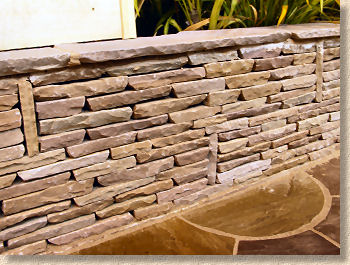
It wasn't all doom and gloom: far from it. Paul is as engaging and convivial as ever, and by drafting in ex-Marley marketing supremo, Denise O'Gara, the company's intentions are clear. They still have great products and there's an irrepressible fount of innovation and drive behind them, but for this one show, they lost direction.
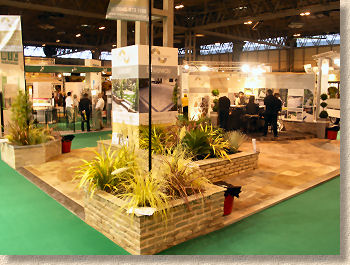
There's to be a greater focus on serving the contractor, with plans to run a national 'Best Patio' and 'Best Driveway' competition later in the year, and to offer incentives such as trips to Europe for those contractors buying a minimum amount of product within a given period. I'm a massive supporter of this type of scheme, as I firmly believe that many suppliers focus too heavily on pandering to every whim and wish of the retailer while forgetting to cater for the installer, who often has an enormous influence over the purchasing decision of the end customer. The 'direct sale' model has been highly successful for some manufacturers on the concrete block market, engendering phenomenal brand loyalty and even affection from grateful contractors, and to learn that Natural Paving plan to emulate this model for the natural stone market is real music to my ears.
Page 1 | Page 2 | Page 3 | Page 4 | | News Index Page

